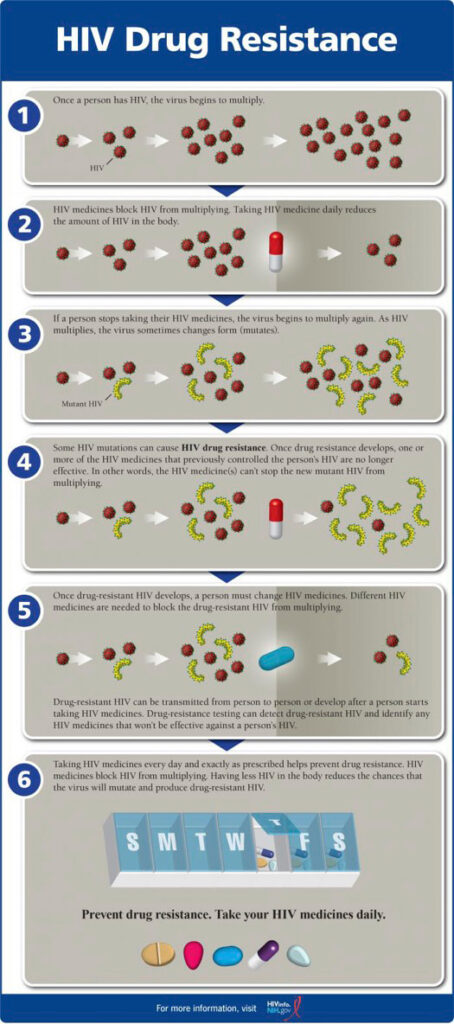HIV is a very sophisticated virus that has the ability to mutate, which means it’s possible for the virus to become resistant to certain HIV medications that a person may have been taking to successfully stop the virus from replicating inside their body. Once a person has been infected with HIV, the virus continues to thrive by making copies of itself, so as that person’s viral load increases, their CD4 count drops. HIV medication is designed to stop the virus from replicating, but it cannot currently eliminate the virus from an infected person.
According to the World Health Organisation (WHO), at the end of 2022, 29.8 million people were receiving antiretroviral therapy (ART) worldwide out of an estimated 39.0 million people currently living with HIV. In the majority of cases, currently available medications are able to successfully stop HIV from replicating and over time, the viral load of a person receiving HIV treatment will usually become undetectable, which means once it reaches this point, the virus cannot be transmitted to other people.
In some cases, antiretroviral medication stops working or isn’t successful to begin with and there can be a number of different reasons for this. When this happens, healthcare professionals will usually prescribe a different type of medication to treat HIV, with several different classes of medications available designed to treat the virus differently. In some extremely rare cases, people can run out of options, but this is highly unlikely to happen these days due to the different types of medication options that are available. These are the three ways HIV drug resistance can occur:
Transmitted HIV drug resistance
This occurs when a person acquires a strain of HIV that is already resistant to one or more HIV drugs. According to data published in 2020, the prevalence of transmitted drug resistance in North America was said to be between 8.5% and 14.2%. This means that it’s possible for a newly infected person to acquire a strain of HIV that is drug resistant, even if that person has never taken HIV medication in the past.
Pretreatment HIV drug resistance
This occurs when a person is exposed to HIV medication when they became infected with HIV. An example of this could be someone who started taking PrEP after being exposed to HIV whilst they were still within the window period. This is why it’s important not to take PREP for the first time right after risky sexual encounters (it must be taken before), as the medication could have a reverse effect. A person should instead take PEP within 72 hours in these situations if they are trying to avoid becoming infected after a risky sexual encounter or be taking PrEP beforehand. According to the World Health Organisation, up to 10% of adults starting HIV treatment can have drug resistance to the non-nucleoside reverse transcriptase inhibitors (NNRTI) drug class, which can be 3 times more common in people with previous exposure to antiretroviral drugs.
Acquired HIV drug resistance
This occurs when a person who has been taking HIV medication experiences a mutated strain of the virus. This can happen by not adhering to medication or taking frequent medication breaks, but it can also happen to those who are strictly adhering to their medication based on how the person’s body reacts to the drug or if the drug is not being absorbed into the body sufficiently. According to the World Health Organisation, surveys conducted between 2015 and 2020 showed the level of viral load suppression among adults receiving ART in North America was approximately 81% receiving first-line ART and 70% receiving second-line ART.
When we hear about HIV drug resistance, we might immediately think that it applies to those who are not taking their medication as prescribed, but this is not always the case, as it’s possible for someone to become infected with a drug resistant strain, which means healthcare professionals will need to find an alternative type of medication that can stop the virus from replicating. Even if a person is adhering to their medication perfectly, it’s still possible for the virus to replicate through mutation as well.
HIV drug resistance can vary from person to person, with some people who have protease mutations making their HIV resistant to protease inhibitors or some people who have reverse transcriptase mutations making their HIV resistant to nucleoside reverse transcriptase inhibitors. Due to antiretroviral medication in the same class working in a similar way, if the virus becomes resistant to one drug within that class, it can become partially or fully resistant to all drugs within that class, so other classes or alternatives might then need to be considered by healthcare professionals.
You can try to prevent drug resistance by making sure you’re on a strong treatment from the beginning, remaining on treatment and adhering to your medications as prescribed. This includes taking medication at a particular time of the day, with or without food, depending on the medication requirements. Healthcare professionals advise that if you miss a dose, make sure you take it as soon as you can, but if it’s close to your next dose, just wait for your next dose. It’s important not to double dose, as this will not help you catch up and just changes the strength of the dose you doubled up on.
NAM Aidsmap has compiled an impressive antiretroviral drug chart that contains the trade name of each drug, the generic name formulation, standard adult dosage, major side effects and food requirements that provides excellent information at a glance, with the chart embedded below, along with a link to the website so you can access the latest information. They have also published an A to Z of antiretroviral medications providing detailed information and fact sheets on their website.
There are two types of drug resistance tests available: genotype testing and phenotype testing. Genotype testing looks for drug resistance mutations in relevant genes of the virus, whereas phenotype testing measures the ability of a person’s virus to replicate in different concentrations of antiretroviral drugs, with genotype testing the more common test conducted, which should be done before starting HIV treatment. Genotypic tests are easier, faster and cheaper, but phenotypic tests can be more accurate under certain circumstances.
From a bug chasing perspective, when someone chooses to stop taking their medication to share HIV with another person, this is a considerable decision to make, as this person is opening themselves up to the possibility that the treatment they have been using may no longer be effective. It’s also possible for a bug chaser to become infected with a drug resistant strain, so both bug chasers and gift givers need to be mindful of the risks involved. HIV drug resistance is something everyone needs to consider, because HIV continues to evolve and it can be unpredictable, meaning you have to expect the unexpected.
References and Further Reading:
- Antiretroviral drugs chart
- Drug Resistance
- Following an HIV Treatment Regimen: Steps to Take Before and After Starting HIV Medicines
- HIV Drug Resistance
- Strategies to overcome HIV drug resistance-current and future perspectives
Featured Photo: Lucio Alfonsi from Pixabay.
Article ID: CC070
Version Control: 1.0 – October 22, 2023: Original article published.









Am I alone or are there more here who get hard reading about med resistant strains?
Hell Frank, no you’re not alone to getting hard about it. More and more guys are hot to be meds off, even to AIDS.
poz since may 2015, pozzed and proud. But 2024 is the med free year! I get hard just thinking about how ny HIV is growing inside me.
Also been regularly swapping toxic poz loads with 2 poz mates, and this weekend we had 2 random toxic poz pigs from Berlin, and I’ll never stop taking and giving toxic poz loads!
Thank you Jason for this well researched and informative article which emphasizes how immunity is created and the reason for starting antiviral treatment so soon after diagnosis.
Thank you for reading this article Tom, and I appreciate your kind words. The more we learn about HIV, the more we discover about how sophisticated and complex the virus can be.
Thanks, Jason, for that well explained article. Lot’s of important material there for those setting out on their long term relationship with hiv.
You’re welcome Dec and I’m glad you found this article helpful, as it does contain some really important information that needs to be considered.
Well written Jason, You explained it better than my PA. I know several people who stop taking their meds for long periods of time and have to start taking a different medication do too the virus being resistant a few yrs later.
Thanks Steven. Virus mutations and drug resistance is something we don’t always think about, yet it’s a very serious situation, especially for those who might only have coverage for certain class drugs as part of their health insurance plans. The purpose of this article is not to frighten anyone, it’s just to provide awareness. The people you know who have experienced this might have been surprised and shocked when they developed drug resistance, so hopefully they’re doing well now on their new medications.
I read a fictional story a year or so ago… Where the virus had mutated to being drug resistance plus progressing much faster than aids…. don’t remember where…it was the early 80’s all over again
There is a concern that this could actually become a reality due to the CRF19 Cuban HIV-1 subtype. Previously, advice was to wait a while before someone started taking drugs following HIV infection, but now it’s recommended to start taking drugs as soon as possible to improve the health of the person and to prevent the spread of HIV to others. Here is a link for more information about CRF19 for anyone who would like to learn more:
https://www.ncbi.nlm.nih.gov/pmc/articles/PMC8376097/